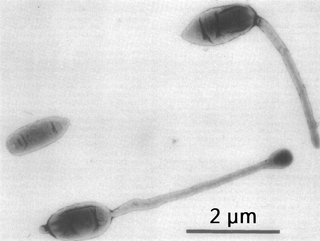
Malassezia is a genus of fungi. It is the sole genus in family Malasseziaceae, which is the only family in order Malasseziales, itself the single member of class Malasseziomycetes. Malassezia species are naturally found on the skin surfaces of many animals, including humans. In occasional opportunistic infections, some species can cause hypopigmentation or hyperpigmentation on the trunk and other locations in humans. Allergy tests for these fungi are available. It is believed French revolutionary Jean-Paul Marat suffered from a fungal infection from Malassezia restricta, which lead to his frequent bathing in a medicinal substance.
Legionella longbeachae is one species of the family Legionellaceae. It was first isolated from a patient in Long Beach, California. It is found predominantly in potting soil and compost. Human infection from L. longbeachae is particularly common in Australia, but cases have been documented in other countries including the United States, Japan, Greece and the UK.

The Hyphomicrobiaceae are a family of bacteria. Among others, they include Rhodomicrobium, a genus of purple bacteria.

Canine coronavirus (CCoV) is an enveloped, positive-sense, single-stranded RNA virus which is a member of the species Alphacoronavirus 1. It causes a highly contagious intestinal disease worldwide in dogs. The infecting virus enters its host cell by binding to the APN receptor. It was discovered in 1971 in Germany during an outbreak in sentry dogs. The virus is a member of the genus Alphacoronavirus and subgenus Tegacovirus.

Protothecosis, otherwise known as Algaemia, is a disease found in dogs, cats, cattle, and humans caused by a type of green alga known as Prototheca that lacks chlorophyll and enters the human or animal bloodstream. It and its close relative Helicosporidium are unusual in that they are actually green algae that have become parasites. The two most common species are Prototheca wickerhamii and Prototheca zopfii. Both are known to cause disease in dogs, while most human cases are caused by P. wickerhami. Prototheca is found worldwide in sewage and soil. Infection is rare despite high exposure, and can be related to a defective immune system. In dogs, females and Collies are most commonly affected.
The Gemmatimonadota are a phylum of bacteria established in 2003. The phylum contains two classes Gemmatimonadetes and Longimicrobia.

Mycolicibacter arupensis is a slowly growing mycobacterium first isolated from soil and human sputum samples in Spain. Etymology: arupense, pertaining to the ARUP Institute for Clinical and Experimental Pathology, where the type strain was characterized.
Mycobacterium caprae is a species of bacteria in the genus Mycobacterium and a member of the Mycobacterium tuberculosis complex. The species is named after the caprines, the organisms from which M. caprae was first isolated. Prior to 2003, the species was referred to as Mycobacterium tuberculosis subsp. caprae. It is also synonymous with the name Mycobacterium bovis subsp. caprae.
Mycobacterium triplex is a species of Mycobacterium.
The Coriobacteriia are a class of Gram-positive bacteria within the Actinomycetota phylum. Species within this group are nonsporulating, strict or facultative anaerobes that are capable of thriving in a diverse set of ecological niches. Gordonibacter species are the only members capable of motility by means of flagella within the class. Several species within the Coriobacteriia class have been implicated with human diseases that range in severity. Atopobium, Olsenella, and Cryptobacterium species have responsible for human oral infections including periodontitis, halitosis, and other endodontic infections. Eggerthella species have been associated with severe blood bacteraemia and ulcerative colitis.
Propionibacterium namnetense is a Gram-positive, anaerobic, pleomorphic and rod-shaped bacterium from the genus Cutibacterium which has been isolated from a samples of human bone infection in Nantes, France.
Epidermidibacterium keratini is a Gram-positive, chemoheterotrophic, non-motile, non-sporeforming, rod-shaped, aerobic bacterium that it was first isolated from human epidermal keratinocytes in 2018. It is part of the normal human flora, typically the skin flora.
Emcibacteraceae is a family of bacteria.
The Temperatibacteraceae are a family of bacteria.
Lawsonella clevelandensis is a species of Actinomycetota.
The Eggerthellaceae are a family of Gram-positive, rod- or coccus-shaped Actinomycetota. It is the sole family within the order Eggerthellales.
Holophagae is a class of Acidobacteriota.
Mycolicibacillus koreensis is a slow-growing, non-chromogenic species of Mycolicibacillus originally isolated from the sputum of a human patient. It grows at temperatures from 25 to 37 °C and is susceptible to quinolones. The genome of M. koreensis contains a tRNA array that contains a long non-coding RNA called GOLDD.
Mycolicibacillus parakoreensis is a slow-growing, non-chromogenic species of Mycolicibacillus originally isolated from the sputum of a human patient. It is susceptible to amikacin, clarithromycin, and rifampin.
Mycobacteroides saopaulense is a species of bacteria from the phylum Actinomycetota belonging to the genus Mycobacteroides that was first isolated from a human patient undergoing LASIK surgery. It has also been isolated from turtles and cows. A strain isolated from mangroves has been demonstrated to produce clavulanic acid and streptomycin. The genome of M. saopaulense contains a tRNA array that contains a long non-coding RNA called GOLDD. M. saopaulense is susceptible to amikacin, kanamycin, and clarithromycin.




